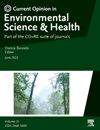无计划污水回用对下游饮用水处理厂消毒副产物形成的影响
IF 6.6
Q1 ENVIRONMENTAL SCIENCES
Current Opinion in Environmental Science and Health
Pub Date : 2025-09-13
DOI:10.1016/j.coesh.2025.100669
引用次数: 0
摘要
事实上的回用(DFR)是指由于上游污水处理厂的废水而意外地将处理过的废水纳入饮用水供应。在美国,近一半的饮用水处理厂(DWTPs)在一定程度上受到DFR的影响,在某些情况下,最大估计DFR百分比流量接近90%。DFR不是美国独有的,在亚洲、欧洲、非洲和其他地区都有报道。排入地表水的经处理废水可能含有大量的无机(如溴化物和碘化物)和有机化合物(如微污染物、细胞外产物和含氮有机物),这些化合物可作为下游污水处理厂中受管制和不受管制的消毒副产物(dbp)的前体。虽然十多年前就确定为国家关注的问题,但缺乏量化和报告DFR的标准化方法阻碍了比较评估和管理决策。我们认为,与水资源社区高度关注管理和监管的间接和直接饮用水再利用相比,DFR被低估或完全忽视了——尽管DFR带来的风险同样真实存在,也同样重要。本文探讨了DFR如何导致dwtp的DBP风险,并结合最近的研究讨论了监测、建模和管理这些风险的策略。本文章由计算机程序翻译,如有差异,请以英文原文为准。
Impacts of unplanned de facto wastewater reuse on disinfection byproduct formation at downstream drinking water treatment plants
De facto reuse (DFR) refers to the unplanned inclusion of treated wastewater in drinking water supplies due to upstream wastewater treatment plant effluents. Nearly half of drinking water treatment plants (DWTPs) in the USA are impacted to some extent by DFR, with maximum estimated DFR percentage streamflow approaching 90% in some cases. DFR is not unique to the U.S. but been reported globally in Asia, Europe, Africa, and others. Treated wastewater discharged to surface waters can contain significant levels of inorganic (e.g. bromide and iodide) and organic compounds (e.g. micropollutants, extracellular products, and nitrogen-containing organic matter) that serve as precursors to both regulated and unregulated disinfection by-products (DBPs) in downstream DWTPs. Although identified as a national concern over a decade ago, the lack of standardized methodologies for quantifying and reporting DFR hinders comparative assessments and regulatory decision-making. We believe DFR is underappreciated or outright ignored as compared to the water community focus on highly managed and regulated indirect and direct potable reuse—although risks from DFR are just as real and important to address. This review explores how DFR contributes to DBP risks at DWTPs and discusses strategies for monitoring, modeling, and managing these risks considering recent research.
求助全文
通过发布文献求助,成功后即可免费获取论文全文。
去求助
来源期刊

Current Opinion in Environmental Science and Health
Medicine-Public Health, Environmental and Occupational Health
CiteScore
14.90
自引率
0.00%
发文量
92
审稿时长
114 days
 求助内容:
求助内容: 应助结果提醒方式:
应助结果提醒方式:


